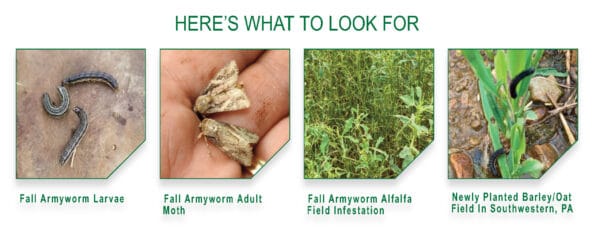Over the last two weeks, reports of Fall Armyworm activity in Pennsylvania have been on the rise, with reports of severe injury in some cases. This is a migratory pest coming from the south where it over winters, and moth flights have been arriving both earlier and at higher numbers than in previous years. Fall Armyworms do not over winter in Pennsylvania or further north. This should put us on alert in pastures, alfalfa forage, late-planted soybean, and in early planted wheat or small grain crops.
Avoid confusing this insect with the “true” armyworm which we are used to seeing in May-June in vegetative corn and other crops. Fall armyworm is much more capable of causing defoliation in crops.
In forages, a threshold that can be used is 2-3 Fall Armyworm larvae per square foot. 1-3 worms per square foot can destroy seedling alfalfa, and higher populations per square foot can destroy 12” alfalfa. Taking an early cut on a stand of alfalfa or hay fields is recommended, then scout the fields after the cutting for additional activity. Fields with sever damage should then be rested for the remainder of fall with no fall cutting. Established alfalfa should come back from Fall Armyworm damage. Recovery of perennial hay grass fields will depend on the severity of the damage.
If you have sprayed your fields for Fall Armyworm control, you should follow up and scout the fields for additional activity a few days later. There are chemical options available, and I recommend consulting your chemical representative or the Penn State Agronomy Guide.

Scott Rushe, Forage Market Development Manager